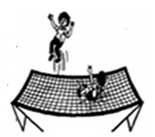问题
选择题
如图是小朋友玩蹦蹦床的情景,对他们在上升和下落过程中机械能的变化,下列分析不正确的是

A.小孩上升到最高点时的重力势能最大
B.没有接触蹦床前,下落的过程中重力势能转化为动能
C.小孩下落到最低点时蹦蹦床的弹性势能最大
D.小孩下落到最低点时的动能最大
答案
答案:D
题目分析:重力势能跟高度有关,小孩上升到最高点时,高度最大,重力势能最大,A对,动能跟速度有关,没有接触蹦床前,下落的过程中速度在增大,高度在减小,故下落的过程中重力势能转化为动能,B对,小孩下落到最低点时弹簧压缩的最多,故这时蹦蹦床的弹性势能最大,C对,小孩下落到最低点时,速度为0,故D错。
